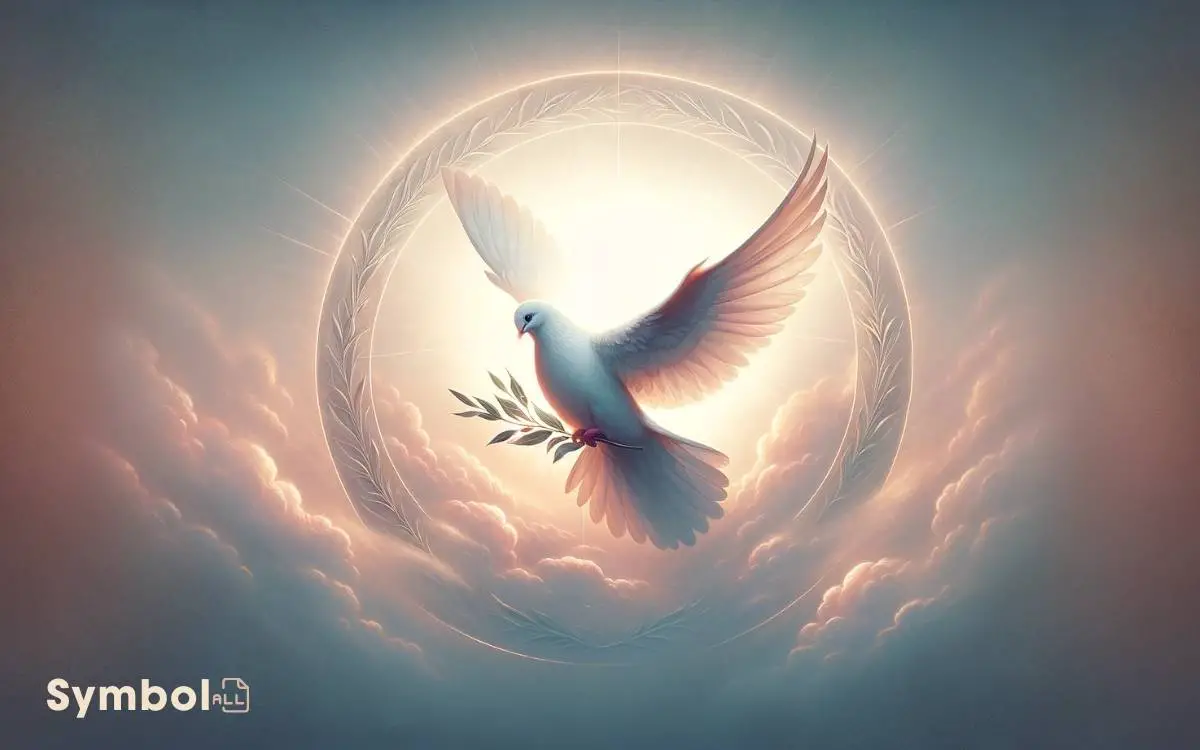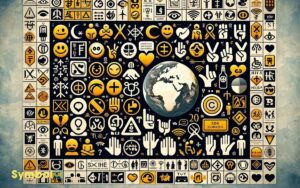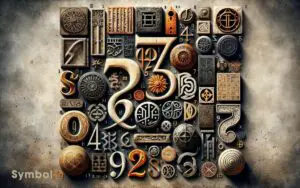A Symbol of the Resurrection Used by Both: Rebirth, Renewal!
You’ll find symbols of resurrection spanning across ancient civilizations and Christian faith, each reflecting a deep-seated yearning for rebirth and renewal.
In ancient Egypt, the scarab beetle signified regeneration, while in Hinduism, the lotus flower represented enlightenment and purity. Similarly, early Christians embraced symbols of resurrection as a cornerstone of faith, symbolizing hope for eternal life.
This thematic overlap shows a collective human desire to transcend mortality. Art and culture further intertwine these symbols, blending beliefs across epochs.
Global interpretations vary, yet the core message remains universal. Exploring further reveals how these symbols adapt and resonate across ages and cultures.

Key Takeaways
The Symbols Ancient Roots
The symbol’s ancient roots trace back to diverse civilizations, where it consistently represented themes of rebirth and renewal across various cultures.
Analyzing its historical significance, you’ll find it deeply embedded in the fabric of ancient mythologies, each adapting its essence to fit their worldviews.
For instance, the Egyptian civilization revered the scarab beetle as a symbol of regeneration, a belief rooted in the insect’s life cycle that mirrored the sun’s daily rebirth.
Similarly, in Hinduism, the lotus flower symbolizes purity and enlightenment, rising from the mud each day to bloom anew.
These symbols transcended mere decorative functions, embodying the universal human experience of overcoming darkness. Their persistence highlights a shared human inclination towards hope, a confirmation to our collective resilience and desire for renewal.
Pagan Reverence and Rituals
As you delve into the world of Pagan reverence and rituals, it’s important to understand how ancient spring celebrations and symbols in nature are interwoven with these practices.
Scholars like Frazer (1890) have documented the profound impact of seasonal changes on these rituals, highlighting the symbolic use of natural elements to signify rebirth and renewal.
This connection offers a rich tapestry for analyzing the continuity and adaptation of these symbols within modern contexts.
Ancient Spring Celebrations
Ancient spring celebrations, deeply rooted in pagan reverence and rituals, symbolize rebirth and renewal through diverse ceremonies and mythologies. These celebrations, often rich with symbolism, engage you in understanding the cyclic nature of life, death, and rebirth.
They embody the essence of transformation, not just in the physical domain but also within the spiritual landscape.
| Culture | Celebration | Key Symbols |
|---|---|---|
| Celtic | Beltane | Fire, Maypole |
| Roman | Floralia | Flowers, Games |
| Germanic | Walpurgis Night | Bonfires, Dancing |
Analyzing these celebrations, you’re invited to see the common threads: community gathering, the use of natural elements to symbolize life’s renewal, and the joyous embodiment of change.
Each tradition, while unique in its expression, shares a universal human acknowledgment of the earth’s rejuvenation, hence revealing a deep-rooted psychological and spiritual significance.
Symbols in Nature
Nature’s tapestry, interwoven with symbols revered in pagan rituals, invites you to explore how the earth’s cycles mirror spiritual beliefs and practices.
The repetition of seasons, from the death of winter to the rebirth of spring, serves as a potent metaphor for rejuvenation and renewal.
This cyclic pattern, observed and celebrated by ancient pagans, underscores the interconnectedness of life, death, and rebirth. The egg, for instance, emerges as a universal symbol of fertility and new beginnings across various pagan traditions (Frazer, 1922).
Similarly, the sprouting seed, breaking through the soil’s surface, symbolizes the triumph of life over death, a theme prevalent in rituals marking the vernal equinox (Green, 1997).
These natural symbols, steeped in pagan reverence, articulate a deep-seated recognition of nature’s role in the spiritual journey.
Christian Adoption and Significance
The adoption of the resurrection symbol by early Christians marks a pivotal moment in religious history, reflecting both a theological affirmation and a profound cultural integration.
This act wasn’t merely adopting a symbol; it was an assertion of belief in life after death, a core tenet of Christian faith.
Early Christian writers, including Tertullian and Augustine, discussed the resurrection extensively, highlighting its centrality to Christian doctrine (Tertullian, ‘On the Resurrection of the Flesh’; Augustine, ‘City of God’).
Their writings underscore the symbol’s significance, not just as a representation of Christ’s resurrection, but as an emblem of hope for eternal life for believers.
This integration of symbol into faith underscored the transformative power of Christianity, blending cultural elements with profound theological insights, thereby enriching the spiritual landscape of early Christian communities.
Artistic Representations Through Ages
You observe the evolution of the resurrection symbol in art, starting with early Christian art symbols that encapsulate the nascent visual language of faith (Murray, 1997).
Moving through the ages, Renaissance interpretations, as analyzed by Panofsky (1955), offer a nuanced understanding of religious iconography, blending classical and Christian elements.
In contemporary times, modern symbolic expressions further abstract these motifs, challenging traditional narratives and inviting diverse interpretations (Smith, 2010).
Early Christian Art Symbols
Often, early Christian art symbols serve as a visual narrative, meticulously capturing the essence of faith and its teachings through time. You’ll find these symbols infused with profound meanings.
The fish, or Ichthys, represents Jesus Christ, God’s Son, Savior, articulating a discreet expression of faith during persecution periods. Similarly, the Good Shepherd iconography exemplifies care and sacrifice, reflecting Jesus’ role in spiritual guidance and protection.
The dove, symbolizing the Holy Spirit, showcases peace and the divine presence. Anchors and alpha-omega motifs further echo eternal hope and the omnipresence of God.
These symbols, embedded in catacombs, sarcophagi, and early Christian manuscripts, not only conveyed the theological virtues of faith, hope, and love but also served as catechetical tools, subtly educating and reinforcing the Christian doctrine among the faithful.
Renaissance Interpretations
As we explore the Renaissance period, artistic interpretations of Christian symbolism underwent a profound transformation, reflecting a shift towards humanism and a deeper exploration of biblical narratives.
Artists began to infuse their works with a more nuanced, personal, and human perspective, diverging from the stylized forms of earlier periods.
This era’s art became a rich tapestry of theological and philosophical ideas, illustrated with unprecedented realism and emotion.
| Artist | Work | Symbolism |
|---|---|---|
| Leonardo | The Last Supper | Bread, Wine |
| Michelangelo | The Creation | Light, Touch |
| Raphael | Transfiguration | Mountain, Light |
| Donatello | Mary Magdalene | Emaciation, Solitude |
These works, emblematic of the Renaissance, underscore the era’s intricate relationship with divine representation, emphasizing a return to a more authentic, experiential understanding of the sacred texts through art.
Modern Symbolic Expressions
Moving forward into the modern era, artists continue to reinterpret Christian symbols with a focus on personal and societal narratives, reflecting the evolving relationship between faith and contemporary life.
This shift is emblematic of a broader trend where traditional religious imagery is reimagined to express modern existential dilemmas, cultural conflicts, and aspirations for spiritual renewal.
For instance, Salvador Dalí’s ‘The Sacrament of the Last Supper’ infuses the biblical theme with surrealistic elements, challenging viewers to contemplate the sacred within the bounds of the profane and the personal.
Similarly, contemporary installations and digital art pieces often incorporate resurrection symbolism to comment on themes of rebirth, resilience, and transformation, underscoring the enduring relevance of these motifs.
These artistic expressions serve not only as a bridge between the sacred and the secular but also as a mirror reflecting society’s ongoing quest for meaning and redemption.
Global Spread and Interpretations
The global dissemination of the resurrection symbol reflects diverse cultural interpretations and adaptations, shaping its significance across various societies.
You’ll find that in each culture, the symbol not only carries the core idea of rebirth and renewal but also integrates local beliefs and rituals, making it a multifaceted symbol with layers of meaning. This fusion of universal themes with regional nuances ensures that the symbol resonates deeply within each community, reflecting their unique traditions and values. Much like quilts as heritage symbols, which stitch together stories of family, history, and identity, these cultural symbols weave a tapestry of shared human experiences. They serve as a bridge between the past and present, continually evolving while honoring their origins.
For instance, in Eastern traditions, the resurrection symbol often interweaves with concepts of karma and reincarnation, adding a cyclic nature to the idea of resurrection (Smith, 2018).
In contrast, Western interpretations, heavily influenced by Christian theology, tend to focus on the singular event of resurrection as a promise of eternal life (Johnson, 2020).
This variation illustrates not just the adaptability of the symbol, but also the universal human fascination with the themes of death and rebirth.
Modern Cultural Resonances
In today’s rapidly evolving societies, the resurrection symbol continues to resonate deeply, reflecting dynamic cultural shifts and technological advancements.
As you explore modern manifestations, it’s clear that this symbol transcends traditional religious boundaries, embedding itself within diverse cultural expressions and digital platforms.
Scholars like Jenkins (2018) argue that the integration of resurrection motifs in contemporary media ranging from films to social media narratives underscores a universal longing for renewal and transformation.
This adaptation illustrates not only the symbol’s versatility but also its capacity to speak to shared human experiences across different contexts.
Additionally, the resurgence of ancient symbols in modern protests and movements, as observed by Thompson (2020), highlights their enduring power to inspire hope and drive societal change, reaffirming the symbol’s relevance amidst modernity’s complexities.
Future Perspectives on Symbolism
Exploring future perspectives on symbolism, researchers anticipate that evolving digital landscapes will further amplify the resonance of ancient symbols, challenging us to explore their meanings in novel contexts.
As you immerse into this dynamic terrain, consider how:
- Digital platforms could serve as a crucible for the reimagining of traditional symbols.
- Virtual reality might offer immersive experiences that deepen our connection to these ancient motifs.
- Social media has the potential to democratize the interpretation of symbols, allowing for a multiplicity of meanings.
- The increasing blend of cultures online could lead to the emergence of new, hybrid symbols.
- Technological advancements may enable the creation of symbols that are more universally accessible and interpretable.
This reevaluation and expansion of symbolic language promise to enrich our collective understanding, ensuring that ancient symbols continue to evolve alongside human societies.
Conclusion
To sum up, the symbol’s journey through time, from its pagan origins to its embrace by Christianity, illustrates a remarkable evolutionary path. As it traversed cultures and epochs, its significance deepened, reflecting both ancient rituals and modern interpretations.
Artistic representations, from Renaissance masterpieces to contemporary digital art, have further cemented its place in global consciousness.
Even in our hyper-digital age, this ancient symbol continues to resonate, suggesting its enduring power to encapsulate complex ideas of rebirth and renewal.
Therefore, its future in symbolism remains promising and vibrant.






